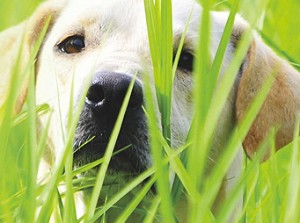Nasty Seeds – Grass Awn Migration Infections
180 – August, 2017
BY CHRIS ROBINSON
 Ordinarily my monthly contribution to the Canine Chronicle looks at the lighter side of dog ownership. But, this month, the topic is deadly serious. For in August and September, certain grasses that can be fatal to your dog begin to ripen and go to seed in many areas of the country.
Ordinarily my monthly contribution to the Canine Chronicle looks at the lighter side of dog ownership. But, this month, the topic is deadly serious. For in August and September, certain grasses that can be fatal to your dog begin to ripen and go to seed in many areas of the country.
Pieces of these seeds, known as awns, can penetrate a dog’s skin, be inhaled or be ingested as the dog runs through these grasses. An grass awn is a short bristle on the end of the seed. Some have plumes that help the wind carry them along. The awns of the troublesome grasses are barbed and those barbs are very effective at catching on fur. Most of the time the awns get tangled in the dog’s hair and they end up dropping off at some point. Occasionally, however, the sharp, pointed part of the seed gets into the dog. Once that begins, because of the barbs, the seed only moves in one direction and that’s forward in the direction of the point. When it gets in a dog’s body, it just keeps traveling and every time the dog moves in some way, the seed moves forward. Many of these awns carry bacteria picked up as they enter the dog’s body or they may carry bacteria that’s normally found in one part of the dog’s body, its mouth, for example, to another part of the body where it is abnormal. Once in the dog’s body, the seeds tend to migrate and as they move, they leave a trail of infection behind. Where it gets tricky is that the seed is continually moving and the infection is generally where the seed was, not where it is at the moment and this makes locating the offending seed difficult. These infections cause illnesses that frequently are difficult to diagnose, not easy to treat and are often fatal if the seed comes in contact with a vital organ.
While there are roughly 11,000 species in the plant family known as grasses, only a portion have awns and an even smaller group have the kind of barbed awns that are a problem for dogs. The awn is part of the sheath that encloses the actual grass seed and help the seeds disperse by attaching to things that come in contact with them. Animals and their fur are one of the ways that grass seeds get transported to new locations. From the standpoint of propagation of the grass variety, attaching to dogs running through these grass areas is an important aspect of survival. However, from the perspective of dogs and their owners, these seeds are a dangerous threat. The guilty grasses include the following: Giant foxtail, foxtail barley, mouse barley, cheatgrass, Canada rye, ripgut brome, Virginia rye and nimbleweed. They are especially hazardous in late summer through early fall as they dry out and the awns loosen becoming more prone to dropping and being caught up in the dog’s fur.
Click here to read the complete article180 – August, 2017
Short URL: https://caninechronicle.com/?p=130194
Comments are closed











